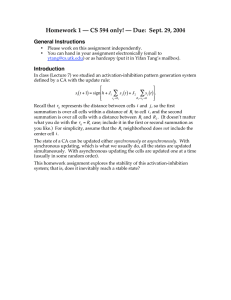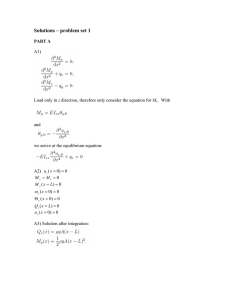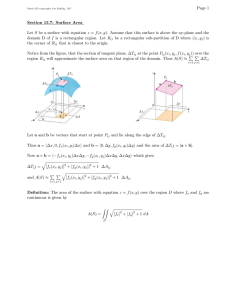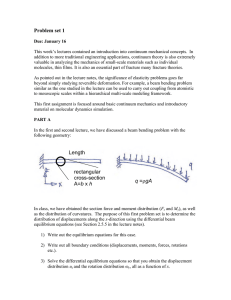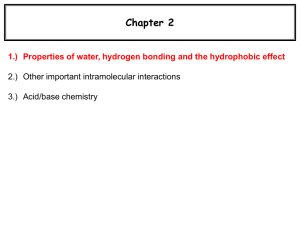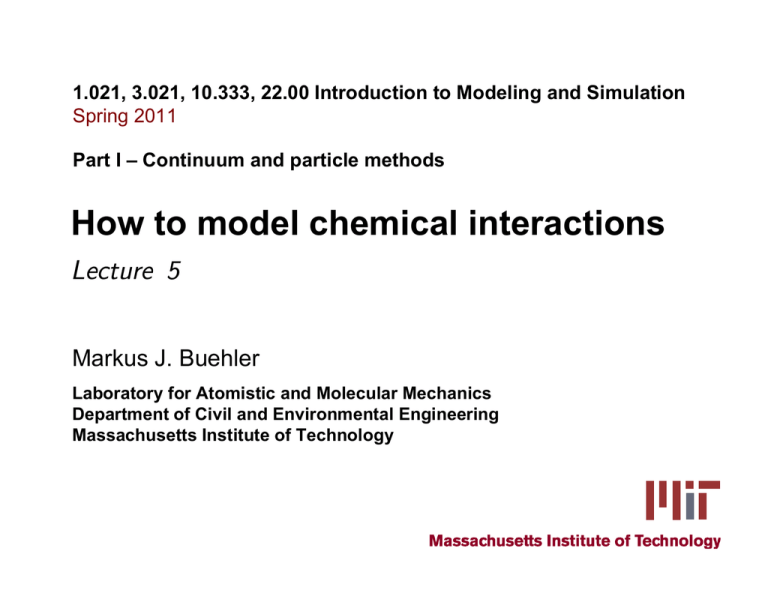
1.021, 3.021, 10.333, 22.00 Introduction to Modeling and Simulation
Spring 2011
Part I – Continuum and particle methods
How to model chemical interactions
Lecture 5
Markus J. Buehler
Laboratory for Atomistic and Molecular Mechanics
Department of Civil and Environmental Engineering
Massachusetts Institute of Technology
1
Content overview
I. Particle and continuum methods
1.
2.
3.
4.
5.
6.
7.
8.
Atoms, molecules, chemistry
Continuum modeling approaches and solution approaches
Statistical mechanics
Molecular dynamics, Monte Carlo
Visualization and data analysis
Mechanical properties – application: how things fail (and
how to prevent it)
Multi-scale modeling paradigm
Biological systems (simulation in biophysics) – how
proteins work and how to model them
II. Quantum mechanical methods
1.
2.
3.
4.
5.
6.
7.
8.
It’s A Quantum World: The Theory of Quantum Mechanics
Quantum Mechanics: Practice Makes Perfect
The Many-Body Problem: From Many-Body to SingleParticle
Quantum modeling of materials
From Atoms to Solids
Basic properties of materials
Advanced properties of materials
What else can we do?
Lectures 1-13
Lectures 14-26
2
Overview: Material covered so far…
Lecture 1: Broad introduction to IM/S
Lecture 2: Introduction to atomistic and continuum
modeling (multi-scale modeling paradigm, difference
between continuum and atomistic approach, case study:
diffusion)
Lecture 3: Basic statistical mechanics – property
calculation I (property calculation: microscopic states vs.
macroscopic properties, ensembles, probability density and
partition function)
Lecture 4: Property calculation II (advanced property
calculation, introduction to chemical interactions, Monte Carlo
method)
Lecture 5: How to model chemical interactions
3
Lecture 5: How to model chemical interactions
Outline:
1. Monte-Carlo (MC) approach: Metropolis-Hastings algorithm
2. How to model chemical interactions
2.1 Pair potentials
2.2 How to model metals: Multi-body potentials
Goals of today’s lecture:
Get to know basic methods to model chemical bonds (starting
with simple “pair potentials”)
Learn how to identify parameters for models of chemical bonds
(for pair potentials)
Limitations of pair potentials – and other, alternative methods
4
1. Monte-Carlo (MC) approach:
Metropolis-Hastings algorithm
5
Averaging over the ensemble
Property A1
Property A2
Property A3
Amacro
C1
C2
1
= ( A1 + A2 + A3 )
3
C3
6
Averaging over the ensemble
Property A1
Property A2
Property A3
Amacro
C1
C2
1
= ( A1 + A2 + A3 )
3
C3
Instead, we must average with proper weights that represent the probability
of a system in a particular microscopic state!
(I.e., not all microscopic states are equal)
Amacro = ρ1 A1 + ρ 2 A2 + ρ 3 A3 =
ρ1 ( r1 , p1 ) A1 ( r1 , p1 ) + ρ 2 ( r2 , p2 ) A2 ( r2 , p2 ) + ρ 3 ( r3 , p3 ) A3 ( r3 , p3 )
Probability to find system in state C1
7
How to solve…
< A >= ∫ ∫ A( p, r ) ρ ( p, r )drdp
p r
Probability density distribution
E.g.:
Virtually impossible to carry out analytically
Must know all possible configurations
Therefore: Require numerical simulation
Molecular dynamics OR Monte Carlo
8
Monte Carlo scheme
Method to carry out integration over “domain”
Ω
Want:
A= ∫
G
f ( x ) dΩ
Ω
E.g.: Area of circle (=π/4
exact solution)
AC =
πd 2
4
AC =
π = 4 AC
π
4
d =1
G ⎧1 inside
f (x ) = ⎨
9
⎩0 outside
Monte Carlo scheme for integration
G
Step 1: Pick random point xi in Ω
Step 2: Accept/reject point based on criterion (e.g. if
inside or outside of circle and if in area not yet counted)
G
Step 3: If accepted, add f ( xi ) = 1
to the total sum
AC = ∫
G
f ( x )dΩ
Ω
1/ 2
AC =
π
16
N A : Attempts
made
1/ 2
Courtesy of John H. Mathews. Used with permission.
G
1
AC =
f ( xi )
∑
NA i
10
How to apply to ensemble average?
Similar method can be used to apply to integrate the
ensemble average
< A >= ∫ ∫ A( p, r ) ρ ( p, r )drdp
p r
⎡ H ( p, r ) ⎤
1
ρ ( p, r ) = exp ⎢ −
⎥
Q
k
T
B
⎣
⎦
“discrete”
NA
< A >= ∑
i =1
A exp(− H ( rA , p A ) / (k BT ))
NA
∑ exp(− H (r , p ) / (k T ))
i =1
A
A
B
Computationally inefficient: If states
are created “randomly” that have low
probability….
To be computationally more effective, need more complex
iteration scheme (replace “random sampling” by “importance
sampling”)
11
Challenge: sampling specific types of
distributions
(
We want to
f ( x ) = exp − (100 x )
Integrate a sharply-peaked
function
Use Monte Carlo with
uniformly-distributed
random numbers (e.g. here
from -1 to 1)
12
)
1
A = ∫ f ( x )dx
−1
1
0.8
0.6
Random numbers
drawn from here
-1
-0.5
0.4
0.2
0.5
1
12
Challenge: sampling specific types of
distributions
We want to
(
f ( x ) = exp − (100 x )
Integrate a sharply-peaked
function
Use Monte Carlo with
uniformly-distributed
random numbers (e.g. here
from -1 to 1)
12
)
1
A = ∫ f ( x )dx
−1
1
0.8
What happens?
Very few points contribute
to the integral (~9%)
Poor computational
efficiency/convergence
Solution: use a different
distribution of random
numbers to sample
“importance sampling”
0.6
Random numbers
drawn from here
-1
-0.5
0.4
0.2
0.5
1
13
Importance sampling
Core concept: Picking states with a biased probability:
Importance sampling (sampling the “correct” way…)
< A >= ∫ ∫ A( p, r ) ρ ( p, r )drdp
p r
⎡ H ( p, r ) ⎤
1
ρ ( p, r ) = exp ⎢−
⎥
Q
k
T
B
⎣
⎦
14
Importance sampling
Core concept: Picking states with a biased probability:
Importance sampling (sampling the “correct” way…)
< A >= ∫ ∫ A( p, r ) ρ ( p, r )drdp
p r
⎡ H ( p, r ) ⎤
1
ρ ( p, r ) = exp ⎢−
⎥
Q
k
T
B
⎣
⎦
Notice: Probability (and thus importance)
related to energy of state
15
Importance sampling: Metropolis algorithm
Leads to an appropriate “chain” of states, visiting each state
with correct probability
Concept:
Pick random initial state
Move to trial states
Accept trial state with certain probability (based on
knowledge about behavior of system, i.e., energy states)
Original reference: J. Chem. Phys. 21,1087, 1953
16
Metropolis-Hastings Algorithm
Concept: Generate set of random microscopic configurations
Accept or reject with certain scheme
State A
State B
Random move to
new state B
17
Metropolis-Hastings Algorithm: NVT
Have: State A (initial state) + energy function H(A)
Step 1: Generate new state B (random move)
a = true/false
for acceptance
Step 2: if H(B)<H(A) then a = 1
else
Draw random number 0 < p < 1
if
⎡ H ( B ) − H ( A) ⎤
p < exp ⎢ −
⎥
k
T
B
⎣
⎦
a=1
else
a=0
endif
endif
a=variable either 0 or 1
(used to detect acceptance
of state B when a=1)
Step 3: if a = 1 then accept state B
endif
“Downhill” moves always accepted, uphill moves
with finite (“thermal”) probability
1
< A >=
A(i )
∑
18
N A i =1.. N A
Metropolis-Hastings Algorithm: NVT
Have: State A (initial state) + energy function H(A)
Step 1: Generate new state B (random move)
a = true[1]/false[0]
for acceptance
Step 2: if H(B)<H(A) then a = 1
else
Draw random number 0 < p < 1
“Downhill” moves
always accepted
if
⎡ H ( B ) − H ( A) ⎤
p < exp ⎢ −
⎥
k
T
B
⎣
⎦
a=1
else
a=0
endif
endif
a=variable either 0 or 1
(used to detect acceptance
of state B when a=1)
Step 3: if a = 1 then accept state B
endif
“Downhill” moves always accepted, uphill moves
with finite (“thermal”) probability
1
< A >=
A(i )
∑
19
N A i =1.. N A
Metropolis-Hastings Algorithm: NVT
Have: State A (initial state) + energy function H(A)
Step 1: Generate new state B (random move)
a = true[1]/false[0]
for acceptance
Step 2: if H(B)<H(A) then a = 1
else
Draw random number 0 < p < 1
“Downhill” moves
always accepted,
uphill moves
with finite
(“thermal”)
probability
if
⎡ H ( B ) − H ( A) ⎤
p < exp ⎢ −
⎥
k
T
B
⎣
⎦
a=1
else
a=0
endif
endif
a=variable either 0 or 1
of state B when a=1)
Step 3: if a = 1 then accept state B
endif
“Downhill” moves always accepted, uphill moves
with finite (“thermal”) probability
1
< A >=
A(i )
∑
20
N A i =1.. N A
Metropolis-Hastings Algorithm: NVT
Have: State A (initial state) + energy function H(A)
Step 1: Generate new state B (random move)
a = true[1]/false[0]
for acceptance
Step 2: if H(B)<H(A) then a = 1
else
Draw random number 0 < p < 1
if
⎡ H ( B ) − H ( A) ⎤
p < exp ⎢ −
⎥
k
T
B
⎣
⎦
a=1
else
a=0
endif
endif
a=variable either 0 or 1
(used to detect acceptance
of state B when a=1)
Step 3: if a = 1 then accept state B
endif
21
Metropolis-Hastings Algorithm: NVT
Have: State A (initial state) + energy function H(A)
Step 1: Generate new state B (random move)
a = true[1]/false[0]
for acceptance
Step 2: if H(B)<H(A) then a = 1
else
Draw random number 0 < p < 1
repeat N A times
if
⎡ H ( B ) − H ( A) ⎤
p < exp ⎢ −
⎥
k
T
B
⎣
⎦
a=1
else
a=0
endif
endif
a=variable either 0 or 1
(used to detect acceptance
of state B when a=1)
Step 3: if a = 1 then accept state B
endif
1
< A >=
A(i )
∑
22
N A i =1.. N A
Arrhenius law - explanation
H ( B ) > H ( A)
E
Consider two states, A and B
H (B )
H ( B ) − H ( A)
H ( A)
A
B
iteration
State B has higher energy than state A
Otherwise accepted anyway!
23
Arrhenius law - explanation
H ( B ) > H ( A)
E
E
H (B )
H ( A)
H ( B ) − H ( A)
H ( B ) − H ( A)
iteration
radius
Energy difference between
states A and B
(“uphill”)
Probability
of success
of overcoming the
barrier at
temperature T
⎡ H ( B ) − H ( A) ⎤
exp ⎢ −
⎥
k
T
B
⎣
⎦
24
Arrhenius law - explanation
Probability
of success
of overcoming the
barrier
⎡ H ( B ) − H ( A) ⎤
exp ⎢ −
⎥
k
T
B
⎣
⎦
Random number 0 < p < 1
(equal probability to draw any number between 0 and 1)
Acceptance if:
⎡ H ( B ) − H ( A) ⎤
p < exp ⎢ −
⎥
k
T
B
⎦
⎣
E.g. when exp(..) = 0.8 most
choices for p will be below,
that is, higher
chance for acceptance
1
….
0.8
low barrier
0.1
high barrier
0
Play “1D darts”
H ( B ) − H ( A)
25
Summary: Metropolis-Hastings Algorithm
Have: State A (initial state) + energy function H(A)
Step 1: Generate new state B (random move)
a = true[1]/false[0]
for acceptance
Step 2: if H(B)<H(A) then a = 1
else
Draw random number 0 < p < 1
repeat N A times
if
⎡ H ( B ) − H ( A) ⎤
p < exp ⎢−
⎥
k
T
B
⎣
⎦
a=1
else
a=0
endif
endif
a=variable either 0 or 1
(used to detect acceptance
of state B when a=1)
Step 3: if a = 1 then accept state B
endif
1
< A >=
A(i )
∑
26
N A i =1.. N A
Summary: MC scheme
Have achieved:
< A >= ∫ ∫ A( p, r ) ρ ( p, r )drdp
p r
1
< A>
Ai
∑
N A i =1.. N A
Note:
• Do not need forces between atoms (for accelerations)
• Only valid for equilibrium processes
27
Property calculation with MC: example
A
Averaging leads to “correct”
thermodynamical property
Error in Monte Carlo decreases as NA
Iteration
“MC time”
28
Complex moves
Move sets can be adapted for other cases, e.g. not just
move of particles but also rotations of side chains
(=rotamers), torsions, etc.
E.g. application in protein folding problem when we’d like
to determine the 3D folded structure of a protein in
thermal equilibrium
29
After: R.J. Sadus
Possible Monte Carlo moves
Trial moves
Rigid body translation
Rigid body rotation
Internal conformational
changes (soft vs. stiff modes)
Titration/electronic states
…
Questions:
How “big” a move should we
take?
Move one particle or many?
Image by MIT OpenCourseWare.
30
Monte Carlo moves
How “big” a move
should we take?
Smaller moves:
better acceptance
rate, slower
sampling
Bigger moves:
faster sampling,
poorer acceptance
rate
Move one particle or
many?
Possible to achieve
more efficient
sampling with
correct multiparticle moves
One-particle moves
must choose
particles at random
Image by MIT OpenCourseWare.
31
2. How to model chemical interactions
32
Atomic interactions – different types of chemical
bonds
Primary bonds (“strong”)
Ionic (ceramics, quartz, feldspar - rocks)
Covalent (silicon)
Metallic (copper, nickel, gold, silver)
(high melting point, 1000-5,000K)
Secondary bonds (“weak”)
Van der Waals (wax, low melting point)
Hydrogen bonds (proteins, spider silk)
(melting point 100-500K)
33
Atomic interactions – different types of chemical
bonds
Primary bonds (“strong”)
Ionic (ceramics, quartz, feldspar - rocks)
Covalent (silicon)
Metallic (copper, nickel, gold, silver)
(high melting point, 1000-5,000K)
Secondary bonds (“weak”)
Van der Waals (wax, low melting point)
Hydrogen bonds (proteins, spider silk)
(melting point 100-500K)
Ionic: Non-directional (point charges interacting)
Covalent: Directional (bond angles, torsions matter)
Metallic: Non-directional (electron gas concept)
Difference of material properties originates from different atomic
interactions
34
Types of bonding (illustrations)
charge
+/electron
density
(localized!)
Ionic bonding
Hydrogen bonding
donor/
acceptor
Covalent bonding
© source unknown. All rights reserved. This content is
excluded from our Creative Commons license. For more
information, see http://ocw.mit.edu/fairuse.
+
+
+
+
+
+
+
+
+
+
+
+
+
+
+
+
+
+
Metallic bonding
35
Wax
Courtesy of Ruth Ruane, http://www.whitewitch.ie. Used with permission.
Soft, deformable, does not break under deformation
36
Rocks
Image courtesy of Wikimedia Commons.
Quite brittle (breaks e.g. during earthquake)
37
Rocks and sand on Mars
What are the properties and composition of extraterrestrial rocks?
Image courtesy of NASA.
Gold
Image courtesy of Wikimedia Commons.
Very “soft” metal, deformable, high density
39
Silicon
Image courtesy of NASA.
Rather brittle – shatters into many pieces if dropped
40
Spider web
Image courtesy of U.S. Fish and Wildlife Service.
Very extensible, deformation, yet very strong (similar to steel)
41
Tree’s leaf
Image courtesy of Wikimedia Commons.
42
Very deformable under bending (wind loads), but breaks easily under tear
Particularly intriguing…brittle or ductile?
BRITTLE
Glass Polymers
Ice...
DUCTILE
Copper, Gold
Shear load
Image courtesy of quinn.anya.
License: CC-BY.
Image by MIT OpenCourseWare.
43
Outline
Goal: model chemical bonds with the objective to enable force
calculation (see lecture 2, basic MD algorithm) or energy
calculation (see lecture 4/5, MC)
Two-step approach:
1. Define energy landscape, i.e. defines how distance between
particles controls the energy stored in the bond
2. Then take derivatives to obtain forces, to be used in the MD
algorithm
“Modeling and simulation” paradigm:
First, develop mathematical expressions (modeling)
Second, use model in numerical solution (simulation, =MD)
44
Models for atomic interactions
Define interatomic potentials that describe the energy of a set of atoms
as a function of their coordinates r:
U total = U total (r )
Depends on position of
all other atoms
G
r = {rj } j = 1.. N
45
Models for atomic interactions
Define interatomic potentials that describe the energy of a set of atoms
as a function of their coordinates r:
G
r = {rj } j = 1.. N
U total = U total (r )
G
Fi = −∇ rKiU total ( r )
Depends on position of
all other atoms
2
i = 1.. N
⎛ ∂
∂
∂ ⎞
⎟
∇ rGi = ⎜⎜
,
,
⎟
∂
∂
∂
r
r
r
⎝ 1,i 2,i 3,i ⎠
Change of potential energy
due to change of position of
particle i (“gradient”)
46
2.1 Pair potentials
47
Pair potentials: energy calculation
Simple approximation: Total energy is sum over the energy
of all pairs of atoms in the system
rij =
rr12
12
distance between
particles i and j
r25
r25
48
Pair potentials: energy calculation
Simple approximation: Total energy is sum over the energy
of all pairs of atoms in the system
rij =
distance between
particles i and j
r12
r25
φ ( rij )
Pair wise
interaction
potential energy
for each bond
49
Pair potentials: energy calculation
Simple approximation: Total energy is sum over the energy
of all pairs of atoms in the system
rij =
φ ( rij )
r12
r25
distance between
particles i and j
Pair wise
interaction
potential energy
for each bond
N
Energy of atom i
U i = ∑ φ ( rij )
j =1
50
Overview - pair potentials: total energy calculation
Simple approximation: Total energy is sum over
the energy of all pairs of atoms in the system
Pair wise
interaction
potential
φ ( rij )
Pair wise summation of bond energies
r12
r25
N
U i = ∑ φ ( rij )
Energy of atom i
j =1
avoid double counting
rij =
distance between
particles i and j
U total =
N
1
2
N
∑ ∑φ (r )
i =1,i ≠ j j =1
ij
51
Example: calculation of total energy
two “loops” over pairs of all
particles
U total =
r12
r25
with
U total
N
1
2
N
∑ ∑φ (r )
i =1,i ≠ j j =1
ij
φij = φ ( rij )
1
= (φ12 + φ13 + φ14 + φ1N ... + φ21 + φ23 + ... + φ2 N + ... + φN −521, N )
2
Interatomic pair potentials: examples
φ ( rij ) = D exp(− 2α ( rij − r0 ) ) − 2 D exp(− α ( rij − r0 ) )
⎡⎛ σ ⎞12 ⎛ σ ⎞6 ⎤
φ ( rij ) = 4ε ⎢⎜⎜ ⎟⎟ − ⎜⎜ ⎟⎟ ⎥
rij ⎠ ⎥
⎢⎝ rij ⎠
⎝
⎦
⎣
⎛σ ⎞
⎛ rij ⎞
φ ( rij ) = A exp⎜⎜ − ⎟⎟ − C ⎜⎜ ⎟⎟
⎝ σ⎠
⎝ rij ⎠
Morse potential
Lennard-Jones 12:6
potential
(excellent model for noble
Gases, Ar, Ne, Xe..)
6
Buckingham potential
Harmonic approximation
(no bond breaking) 53
How to use a pair potential, e.g. LJ
54
Force calculation – pair potential
Forces on particles can be calculated by taking derivatives from the potential
function & by considering all pairs of atoms
Start with force magnitude (STEP 1): Negative derivative of potential
energy with respect to atomic distance
d φ ( rij )
d φ (r)
F =−
= −φ ' ( rij )
| =−
d rij
d r r = rij
j
rij
i
f
f1
x2
f2
x1
x2
55
x1
Force calculation – pair potential
Forces on particles can be calculated by taking derivatives from the potential
function & by considering all pairs of atoms
Start with force magnitude (STEP 1): Negative derivative of potential
energy with respect to atomic distance
d φ ( rij )
d φ (r)
F =−
= −φ ' ( rij )
| =−
d rij
d r r = rij
Calculate force vector (STEP 2):
xi
fi = F
rij
G
rij = rij
Component
G i of
vector rij
j
G
f = f i ei
i
rij
f
f1
x2
f2
x1
x2
56
x1
What can we do with this potential?
57
Bending a copper wire until it breaks
58
A closer look
Courtesy of Goran Drazic. Used with permission.
59
http://www2.ijs.si/~goran/sd96/e6sem1y.gif
Case study: plasticity in a micrometer crystal of
copper
Simulation details
- 1,000,000,000 atoms (0.3 micrometer
side length)
φ
r
- 12:6 Lennard-Jones ductile material,
for copper
- Visualization using energy filtering
method (only show high energy atoms)
Generic
features of
atomic
bonding:
„repulsion vs.
attraction“
[001]
X
Z
[1 1 0]
(1 1 0)
Crack faces
[010]
[1 1 0]
Crack Direction [1 1 0]
Mode 1 tensile loading
Y
Image by MIT OpenCourseWare. After Buehler, et al., 2005.
y
x = [110]
= [100]
z = [001]
Image by MIT OpenCourseWare. After Buehler, et al., 2005.
60
A simulation with 1,000,000,000 particles
Lennard-Jones - copper
Fig. 1 c from Buehler, M., et al. "The Dynamical Complexity of Work-Hardening: A Large-Scale
Molecular Dynamics Simulation." Acta Mech Sinica 21 (2005): 103-11.
© Springer-Verlag. All rights reserved. This content is excluded from our Creative Commons
license. For more information, see http://ocw.mit.edu/fairuse.
61
??
Image by MIT OpenCourseWare.
Strengthening caused by hindering
dislocation motion
If too difficult, ductile modes break
62
down and material becomes brittle
Parameters for Morse potential
(for reference)
63
Morse potential parameters for various metals
Morse Potential Parameters for 16 Metals
Metal
αa0
β
L x 10-22 (eV)
α (Α−1)
r0 (Α)
D (eV)
Pb
2.921
83.02
7.073
1.1836
3.733
0.2348
Ag
2.788
71.17
10.012
1.3690
3.115
0.3323
Ni
2.500
51.78
12.667
1.4199
2.780
0.4205
Cu
2.450
49.11
10.330
1.3588
2.866
0.3429
Al
2.347
44.17
8.144
1.1646
3.253
0.2703
Ca
2.238
39.63
4.888
0.80535
4.569
0.1623
Sr
Mo
2.238
2.368
39.63
88.91
4.557
24.197
0.73776
1.5079
4.988
2.976
0.1513
0.8032
W
2.225
72.19
29.843
1.4116
3.032
0.9906
Cr
2.260
75.92
13.297
1.5721
2.754
0.4414
Fe
1.988
51.97
12.573
1.3885
2.845
0.4174
Ba
1.650
34.12
4.266
0.65698
5.373
0.1416
K
1.293
23.80
1.634
0.49767
6.369
0.05424
Na
1.267
23.28
1.908
0.58993
5.336
0.06334
Cs
Rb
1.260
1.206
23.14
22.15
1.351
1.399
0.41569
0.42981
7.557
7.207
0.04485
0.04644
Adapted from Table I in Girifalco, L. A., and V. G. Weizer. "Application of the Morse Potential Function
to Cubic Metals." Physical Review 114 (May 1, 1959): 687-690.
Image by MIT OpenCourseWare.
φ ( rij ) = D exp(− 2α ( rij − r0 ) ) − 2 D exp(− α ( rij − r0 ) )
64
Morse potential: application example (nanowire)
Source: Komanduri, R., et al. "Molecular Dynamics (MD) Simulation of Uniaxial Tension of Some SingleCrystal Cubic Metals at Nanolevel." International Journal of Mechanical Sciences 43, no. 10 (2001): 2237-60.
Further Morse potential parameters:
Courtesy of Elsevier, Inc., http://www.sciencedirect.com. Used with permission.
65
Cutoff-radius: saving time
66
Cutoff radius
N
U i = ∑ φ ( rij )
j =1
6
…
i
j=1
Ui =
5
4
∑φ (r )
j =1.. N neigh
φ
~σ
2
ij
LJ 12:6
potential
3
rcut
ε0
rcut
Cutoff radius = considering interactions only to a certain distance
Basis: Force contribution negligible (slope)
r
67
Derivative of LJ potential ~ force
rcut
0.1
ο
-dφ/dr (eV/A)
0.2
dφ(r)
F = _ _____
dr
0
Potential shift
-0.1
-0.2
2
r0
3
4
5
o
r (A)
Image by MIT OpenCourseWare.
Beyond cutoff: Changes in energy (and thus forces) small
68
Putting it all together…
69
MD updating scheme: Complete
(1) Updating method (integration scheme)
2
ri (t0 + Δt ) = −ri (t0 − Δt ) + 2ri (t0 )Δt + ai (t0 )(Δt ) + ...
Positions
at t0-Δt
Positions
at t0
Accelerations
at t0
(2) Obtain accelerations from forces
f i = mai
ai = f i / m
(4) Crystal (initial conditions)
Positions at t0
(3) Obtain forces from potential
d φ (r)
F =−
dr
Potential
xi
fi = F
r
⎛ ⎡ σ ⎤12 ⎡ σ ⎤ 6 ⎞
φ ( r ) = 4ε ⎜⎜ ⎢ ⎥ − ⎢ ⎥ ⎟⎟
⎣r⎦ ⎠
⎝⎣ r ⎦
70
2.2 How to model metals: Multi-body
potentials
Pair potential: Total energy
sum of all pairs of bonds
Individual bond contribution
does not depend on other atoms
“all bonds are the same”
Courtesy of the Center for Polymer
Studies at Boston University. Used
with permission.
Is this a good assumption?
U total =
N
1
2
N
∑ ∑φ (r )
i =1,i ≠ j j =1
ij
71
Are all bonds the same? - valency in hydrocarbons
Ethane C2H6
(stable configuration)
All bonds are not the same!
H
Adding another H is not favored
72
Are all bonds the same? – metallic systems
stronger
+ different
bond EQ
distance
Surface
Bulk
Pair potentials: All bonds are equal!
Reality: Have environment
effects; it matter that there is a
free surface!
Bonds depend on the environment!
73
Are all bonds the same?
Bonding energy of red atom in
is six times bonding energy in
This is in contradiction with both experiments and more accurate quantum
mechanical calculations on many materials
N
Bonding energy of atom i
U i = ∑ φ ( rij )
j =1
6
U i = ∑ φ ( rij )
j =1
U i = φ ( rij )
74
After: G. Ceder
Are all bonds the same?
Bonding energy of red atom in
is six times bonding energy in
This is in contradiction with both experiments and more accurate quantum
mechanical calculations on many materials
For pair potentials
For metals
~ Z
~Z
Z:
Coordination = how many
immediate neighbors an atom has
Bonds get “weaker” as more atoms are added to central atom
75
After: G. Ceder
Bond strength depends on coordination
energy per bond
~ Z pair potential
~ Z
Nickel
2
4
6
8
10 12
Z
coordination
76
Daw, Foiles, Baskes, Mat. Science Reports, 1993
Transferability of pair potentials
Pair potentials have limited transferability:
Parameters determined for molecules can not be used
for crystals, parameters for specific types of crystals can
not be used to describe range of crystal structures
E.g. difference between FCC and BCC can not be
captured using a pair potential
77
Metallic bonding: multi-body effects
Need to consider more details of chemical bonding to
understand environmental effects
Electron (q=-1)
+
Ion core (q=+N)
+ + + + + +
+ + + + + +
+ + + + + +
Delocalized valence electrons moving between nuclei generate a
binding force to hold the atoms together: Electron gas model
(positive ions in a sea of electrons)
Mostly non-directional bonding, but the bond strength indeed
depends on the environment of an atom, precisely the electron
density imposed by other atoms
78
Concept: include electron density effects
π ρ , j ( rij )
Each atom features a particular distribution of electron density
79
Concept: include electron density effects
Electron density at atom i
π ρ , j ( rij )
ρi =
∑π ρ
j =1.. N neigh
,j
( rij )
Atomic electron
density of atom j
j
rij
i
Contribution to electron density at site i due to electron
density of atom j evaluated at correct distance (rij)
80
Concept: include electron density effects
1
φi = ∑
φ ( rij ) + F ( ρ i )
j =1.. N neigh 2
Embedding term F
(how local electron
density contributes to
potential energy)
Electron density at atom i
π ρ , j ( rij )
j
i
ρi =
∑π ρ
j =1.. N neigh
,j
( rij )
Atomic electron
density of atom j
81
Embedded-atom method (EAM)
Atomic energy
new
1
φi = ∑
φ ( rij ) + F ( ρ i )
j =1.. N neigh 2
Pair potential energy
ρi
Total energy
N
U total = ∑ φi
i =1
Embedding energy
as a function of electron
density
Electron density at atom i
based on a “pair potential”:
ρi =
∑π ρ
j =1.. N neigh
,j
( rij )
First proposed by Finnis, Sinclair, Daw, Baskes et al. (1980s)
82
Physical concept: EAM potential
Describes bonding energy due to electron delocalization
As electrons get more states to spread out over their kinetic
energy decreases
When an impurity is put into a metal its energy is lowered
because the electrons from the impurity can delocalize into
the solid.
The embedding density (electron density at the embedding
site) is a measure of the number of states available to
delocalize onto.
Inherently MANY BODY effect!
83
Effective pair interactions
r
Effective pair potential (eV )
1
++++++
++++++
++++++
Bulk
0.5
Surface
r
0
-0.5
2
3
4
o
r (A)
Image by MIT OpenCourseWare.
++++++
++++++
++++++
Can describe differences between bulk and surface
84
See also: Daw, Foiles, Baskes, Mat. Science Reports, 1993
Summary: EAM method
State of the art approach to model metals
Very good potentials available for Ni, Cu, Al since late
1990s, 2000s
Numerically efficient, can treat billions of particles
Not much more expensive than pair potential
(approximately three times), but describes physics much
better
Strongly recommended for use!
85
MIT OpenCourseWare
http://ocw.mit.edu
3.021J / 1.021J / 10.333J / 18.361J / 22.00J Introduction to Modeling and Simulation
Spring 2012
For information about citing these materials or our Terms of use, visit http://ocw.mit.edu/terms.

